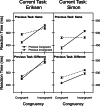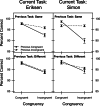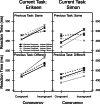Effects of conflict trial proportion: A comparison of the Eriksen and Simon tasks
- PMID: 33269440
- PMCID: PMC7884373
- DOI: 10.3758/s13414-020-02164-2
Effects of conflict trial proportion: A comparison of the Eriksen and Simon tasks
Abstract
Two experiments examined global and local behavioral adaptation effects within and across the Eriksen task, where conflict is based on stimulus letter identities, and the Simon task, where conflict is based on stimulus and response locations. Trials of the two tasks were randomly intermixed, and the list-wide proportion of congruent trials was varied in both tasks (Experiment 1) or in just one task (Experiment 2). The global adaptation effect of list-wide congruency proportion (LWPC effect) was at least as large in the Simon task as in the Eriksen task. Likewise, the local adaptation effect of previous-trial congruency (Gratton effect) was at least as large in the Simon task as in the Eriksen task. In contrast to prior studies investigating transfer across Stroop and Simon tasks, there was no dissociation between global and local adaptation effects regarding their transfer across the different conflict tasks. In fact, both local and global adaptation effects appeared largely task-specific, because there was no or only little transfer of either Gratton effects or LWPC effects from the Eriksen to the Simon task or vice versa. On the whole, the results suggest that behavioral adaptation observed in the present design does not carry over from one of these tasks to the other, suggesting no involvement of a higher-order, task-general mechanism of cognitive control.
Keywords: Attention and executive control; Cognitive control; Conflict tasks; Congruency proportion; Contingency learning; Eriksen task; Gratton effect; Simon task.
Figures












References
-
- Aben B, Verguts T, Bussche EVD, Aben B, Verguts T. Beyond trial-by-trial adaptation: A quantification of the time scale of cognitive control. Journal of Experimental Psychology: Human Perception and Performance. 2017;43:509–517. - PubMed
-
- Aben B, Iseni B, Bussche EVD, Verguts T. Persistent modification of cognitive control through attention training. Quarterly Journal of Experimental Psychology. 2019;72:413–423. - PubMed
-
- Akçay Ç, Hazeltine E. Conflict monitoring and feature overlap: Two sources of sequential modulations. Psychonomic Bulletin and Review. 2007;14:742–748. - PubMed
-
- Akçay Ç, Hazeltine E. Conflict adaptation depends on task structure. Journal of Experimental Psychology: Human Perception and Performance. 2008;34:958–973. - PubMed
-
- Akçay Ç, Hazeltine E. Domain-specific conflict adaptation without feature repetitions. Psychonomic Bulletin and Review. 2011;18:505–511. - PubMed
MeSH terms
LinkOut - more resources
Full Text Sources

